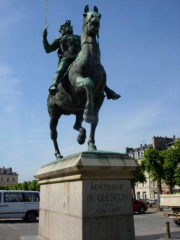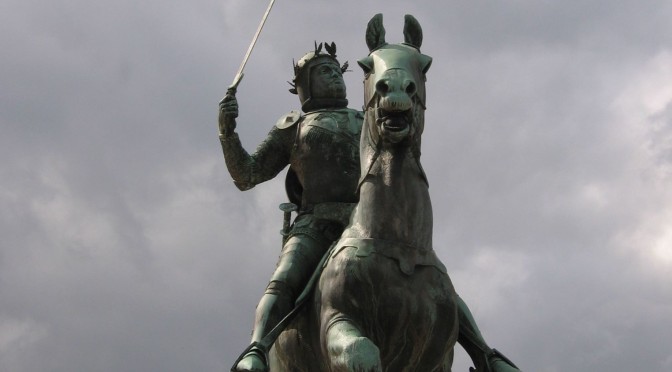 Bertrand is evil, but courageous when there is no alternative. He is the one who said " I have a secret weapon,its name is Terror.
Bertrand is evil, but courageous when there is no alternative. He is the one who said " I have a secret weapon,its name is Terror.
Bertrand is evil. There is no other word for it.
Rather than wite a complete profile I enclose an extract from the Isle of Jersey information brochure.
“In the main square of the Breton town of Dinan there is a fine equestrian statue of Bertrand du Guesclin, Constable of France, guerrilla fighter, knight, master of siege warfare and all-round gallic hero.
There is no similar statue in Jersey – and for a very good reason. In 1373, while Sir William Asthorpe was Warden of the Channel Islands and Jean de St Martin was chief justice or Bailiff, du Guesclin, accompanied by the Duke of Bourbon, led a large invasion force of his French compatriots to the Island’s shores.
The Black Dog of Brittany – or, more accurately, La Dogue Noir de Brocéliande, the great Breton forest – as du Guesclin was known, soon overran the Island, capturing Grosnez Castle in the process. His forces also burned property and killed Islanders indiscriminately.
Some idea of his brutality can be gathered from accounts of du Guesclin’s campaigns in northern Spain, where Jews and Moors were systematically put to the sword or even burned alive.”
Attack on Jersey
With no water supply and limited defences, Grosnez was no real obstacle to a soldier well versed in the siege tactics, but Mont Orgueil – then known simply as Le Château de Gorey – was another matter.
In the 14th century this stronghold was well fortified, having not only stout outer ramparts and towers but also a strong keep built on the bedrock of the familiar promontory overlooking the sea.
The French forces managed to tunnel under the outer walls, undermining their structure and making a breach, but the defenders fell back to the keep.
Because this was on solid rock further attempts to dig tunnels were futile, so a stalemate ensued. Sir William, who commanded the castle garrison with Jean de St Martin, recognised that the reserves of food were limited.
Accordingly, he negotiated with du Guesclin, saying that the castle would be surrendered at Michaelmas if help did not arrive.
That gave both sides two months to sit and wait for developments.
Fortunately for everyone who is content that the Channel Islands have remained English Crown possessions, an English fleet arrived in time to lift the siege.
But that was not the end of the matter.
The armies of du Guesclin were still in a position to raid Jersey at will, so they had to be bought off with a substantial ransom.
Interestingly, Sir William’s wife, Margaret Dynham, came originally from the Dinan area – as did du Guesclin. It has been suggested that she interceded on behalf of the Island.
As significant as the Black Dog’s 1373 raid on the Island was for the Islanders of the era, it was a mere sideshow in a military career of one of France’s great warriors.
Resurrected Neanderthal
Born in 1320 at La Motte-Broons, which lies south-west of Dinan, du Guesclin initially served Charles of Blois in the War of the Breton Succession.
Great soldier though he was, he was not an attractive figure. Contemporary descriptions say that he was short and had disproportionately long arms, a snub nose and protruding eyes.
More recently, a French student of his career suggested that he might have been a resurrected Neanderthal. As well as remaining illiterate throughout his life, du Guesclin was said to be aggressive and bad-tempered.
In 1356 du Guesclin successfully held the city of Rennes against an English attack, winning a duel with Sir Thomas Canterbury during the course of the siege. In 1364 he entered the service of Charles V of France and won a brilliant victory at Cocherel over the forces of Charles II of Navarre.
However, in the same year he was captured by the English under Sir John Chandos at Auray in southern Brittany, but he was ransomed by Charles V for the huge sum of 40,000 gold francs, who put him in charge of the ‘free companies’, soldiers who marauded throughout France after the Treaty of Brétigny between England and France put a temporary halt to the Hundred Years War.
Du Guesclin in Castile
Soon afterwards de Guesclin was sent to Spain to help Henry of Trastamara, who later became Henry II of Castille, against Peter the Cruel. He met with mixed fortunes, fighting successfully at first but then being captured in 1367 by Peter and England’s Black Prince at Najera.
Two years later, however, he won the Battle of Montiel, gaining the throne of Castille for Henry. In the same year war with England resumed and du Guesclin first captured Poitou and then chased the English army into his native Brittany.
Further victories followed, but he died in 1380 – not in his bed but at Châteauneuf-de-Randon during the course of a military expedition to the Languedoc in southern France.”
This article originally appeared as part of the Jersey Evening Post Crowns in Conflict series, compiled for the 1204-2004 celebrations.
